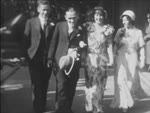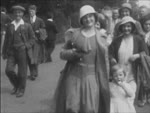WADING BIRDS / LIONS
Please read Understanding catalogue records for help interpreting this information and Using footage for more information about accessing this film.
Title: WADING BIRDS / LIONS
Reference number: 6528
Date: 1930 c
Production company: Pathescope
Sound: silent
Colour: bw
Fiction: non-fiction
Running time: 2.46 minsc
Description: Two Pathescope educational shorts spliced together. Wading birds followed by film on lions, both with frequent intertitles.
Credits: Pathescope presents
Shotlist:
TITLE. The birds of this order are known by the great length of their legs, which enable them to wade in water whilst keeping their bodies dry a useful asset for those who visit England! Bird in cage. Their necks and beaks are abnormally long so that they have no difficulty in picking worms and insects from the mud and marshy places. C/u bird long beak. To prevent them sinking in the mud and slime, they posses long toes which in many cases are webbed. C/u webbed feet. Here we see the Stork, found mostly in Holland and Germany. He stands about 3ft to 4ft high. Gvs bird. He builds his nest on housetops and among the chimneys; and there he stays until Autumn, when he migrates with a large flock of his kind to Africa. Large nest on top of tree. Shore-wading birds. The Heron is about 3ft in length. They are found as far North as Russia, but continue all year round in France, Holland an (sic) Britain. He possesses an insatiable appetite and is great fish eater, in fact Friday is no novelty to him! Gvs Heron. About the same size as the Heron is the Crane, whom we see here. He lives usually in the marshy districts around Lincolnshire and Cambridgeshire and feeds on small fish and insects. Two cranes. The crane is very keen-sighted and lives to an old age. C/u head. The Marabou Stork (about 4ft 6 ins high) lives in Africa, India and Indo-China. It has a very long and strong beak. It is peculiar in having a bald head - we wonder if he has been making out his Income Tax return. Brief view stork flapping wings. This queer looking fellow is the Spoon-Bill, so named on account of his spoon-shaped beak, with which he digs for his food. This consists of frogs, lizards etc. He lives in high trees and is to be seen in the North during summer and in the South during winter. View two birds in a circular frame. This is not "early doors" at a sale; but merely a flock of Flamingoes! These birds live mostly in Central Asia. Flamingoes in water and walking in park. This neat little fellow - the Moor-Hen - is to be found in marshy districts where it nests in low trees or shrubs by the waterside. It feeds on grass and small roots and the insects that infest them. Gvs bird in foliage. The woodcock is a little smaller than the partridge. They are migratory birds coming to Britain in the Autumn and leaving in the Spring. The flesh is held very delicate and hence is he is eagerly sought after by sportsmen. The Woodcock frequents wet and swampy woods. Gvs. This bird is the Redshank - so called from its crimson coloured legs. He delights in fen countries and in wet an marshy districts. In size he may be reckoned between the Lapwing and the Snipe. Gvs bird in water. Note its long thin beak and pointed tongue. C/u. The Avoset or Secretary Bird is found on the shores of the Atlantic Ocean. Gvs. It has a particularly strong curved beak. C/u. Running birds. The Bustard is the largest bird found in Europe and is greatly valued for its eating qualities. It is said to post sentinels to guard its mates when at rest or feeding. Circular frame view. The Lapwing, whom we see hear, is found in almost every country. It bears a splendid crest on its head. The Lapwing is extremely affectionate and attentive to its young. It nests on the ground in open and exposed places. Gvs. A Pathescope film. Pathescope presents. The subject has very kindly come to "sit" for an amateur photographer. Large male lion on a log, surrounded by men in uniform, black skipped hats (zookeepers?). Lion jumps off log. Charles GAYS who loves there gambols, loves his boarders and sometimes takes part in their games. Lioness leaping off log onto man. Others follow. He appreciates there very frank manner of testifying to their attachment and gratitude. Man hugging lions as they lick and show affection. Man smiling. When quite young, a special nourishment prevents their tendency towards savagery from developing itself. Line of lion cubs eating from bowls. From a very early age, they are accustomed to the presence of man and to contact with him. Men in uniform holding lion cubs and posing for camera. The End.






